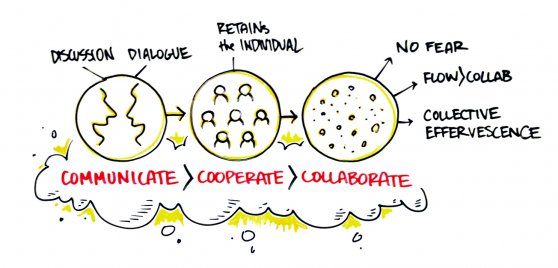One of my favorite parts of leading Collective Next is watching good ideas emerge, take root, and grow without my involvement. One such idea has been Transcribe Live in the Lab, a meeting of the minds every Friday afternoon with the simple goal of seeing what percolates. This whitespace has become an important forum for us as a community to engage each other in conversations that are normally squeezed out by the demands of delivering work and running a business. In doing so, we are able to step back, reflect, and gain new levels of clarity.
This past Friday’s lab was particularly illuminating for me. From a conversation that began with a simple exploration of the role of crowd sourcing, we delved into the nature of how human beings come together, and ultimately, we were able to further clarify the fundamentals of the work we do here at Collective Next.
Our efforts have always gravitated toward “collaboration” and those special moments where people come together to achieve something not possible without the group. However, this word, “collaboration”, has been used in so many contexts that its meaning has become a bit elusive. Its use has become so ubiquitous that it is at risk of ending up on the jargon scrap heap.
So let me offer the beginning of a framework we sketched out in the Lab. People come together across a continuum of interactions that fall into three primary categories: Communication, the exchange of ideas and information; Cooperation, the alignment of effort and co-production of outcomes; and Collaboration, a collective act of creativity or invention where the output is inherently unique to the people involved.
 Illustration by Evan Wondolowski
Illustration by Evan Wondolowski
This framework opened for us a set of interesting questions. What are the best uses for each type of group interaction? How do you most effectively catalyze each interaction type? Does group size matter, and related to crowd sourcing, the genesis of the conversation, can there be such a thing as mass-collaboration? Can thousands, even millions participate in true acts of co-creation?
Back




